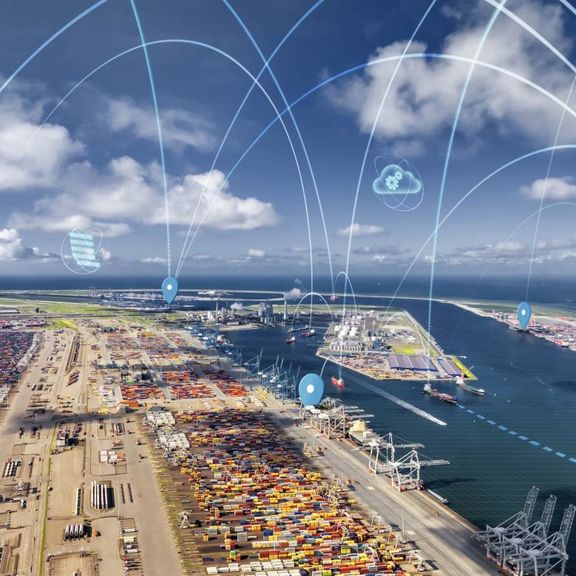digitization of core activities
The following projects are particularly relevant when we review Rotterdam’s programme of digitalisation initiatives in the interest of a more effective management and development of the port and the port infrastructure:
- HaMIS: The Port Management Information System (Haven Management Informatie Systeem, HaMIS) is the central system for the administrative settlement, guidance and inspection of port calls. Both Rotterdam and Amsterdam use this system, making it easier to exchange information. HaMIS helps to both reduce paperwork and avoid double checks – resulting in more client-friendly procedures. HaMIS was set up around an interactive system that allows users to plan, monitor and process all shipping traffic. This tool forms an effective means to manage shipping movements in the port area.
- PortMaps: PortMaps is the digital version of Rotterdam’s geographical chart of the port area. With a few mouse clicks, users gain access to all relevant information about a specific location – whether this concerns maintenance reports, a commercial or environmental zone , contracts, assets, original specifications or a cross-section, local water depths in the port or the location of pipelines or power cables.
- Smart Infra: Fitting the port infrastructure with sensors and data communications devices (Internet of Things) has yielded a mass of useful information about, for example, the duration and intensity of a specific object’s use. This data can serve as input for optimising objects’ design, maintenance and commercial agreements. This project not only involves mooring structures like jetties, buoys and dolphins, but also extends to sensors that measure to which extent waste containers near inland shipping berths are filled or the capacity utilisation of parking spaces in the port. The digitalisation of the port infrastructure also enables the remote monitoring and control of power facilities (e.g. solar panels installed on a dolphin).
- Floating Lab: The Port Authority has fitted one of the Harbour Master Division’s former harbour patrol boats (RPA3) with an array of cameras, measuring devices and sensors for the development and testing of new applications in the field of smart shipping and autonomous shipping. The Floating Lab is currently testing camera systems in combination with radar data. An interesting next step would be to convert the Floating Lab into a remote-controlled vessel.
Portbase
Portbase is a joint venture of the Port of Rotterdam Authority and Port of Amsterdam. It was set up to create a Port Community System for the port of Rotterdam and provide a digital portal f or its users. Portbase’s Port Community System enables the automated exchange of various reports and declarations between private parties and government agencies. Thanks to the wide range of applications incorporated in the system, this data can also be used for other purposes as part of an automated process. The smart re-use of data leads to fewer opportunities for human error and allows the different parties to minimise their liability risks and administrative workload. As a result, the logistics process is considerably speeded up and parties can turn to a central location for the digital exchange of relevant data (paperless ports). Portbase ensures that all core processes in all Dutch ports run as intended. Thousands of users have joined the Port Community System (PCS), benefiting daily from the services offered via Portbase in the Netherlands’ sea ports and inland ports. Whether they need to submit a compulsory report to the Harbour Master or a government agency, safely exchange data with another company or manage authorisations and access to information, Portbase enables over 4,700 companies to go about their business in all the Netherlands’ ports via efficient, paperless procedures.
The Port Community System’s data and level of coverage has proven of tremendous value to everyone working to innovate and improve the logistics chain. Portbase allows companies that require data and connectivity to access and use the information stored within the system – with the owner’s consent, of course. Thanks to the Port Community System’s national coverage and network of connections, parties can rest assured that their new and innovative solutions will reach a maximum number of potential users. In addition, Portbase strengthens the Netherlands’ position as an attractive logistics data hub for major international players that plan to do business in and via the Netherlands. These platforms are primarily interested in locations throughout Europe that have an efficient and reliable physical and digital infrastructure. They want to connect with systems where local legislation does not impede business and where existing networks offer solid geographical coverage for the swift and efficient transport of freight to and from the hinterland. This creates a ‘digital twin’ of the physical port area, which incorporates a variety of chains on the basis of trust, connectivity and access to data.
Autonomous shipping and the ‘digital twin’
We are in the midst of an array of technological developments that, in time, will enable autonomous aircraft and vehicles. And undoubtedly, this trend will also extend to shipping at some point in the future. All the aforementioned projects also contribute to the Port Authority’s ambition to enable autonomous shipping within the port of Rotterdam by the year 2030. An important step in this process is the development of the port’s ‘digital twin’. This digital version incorporates all manner of data about the port area, including all infrastructure objects, shipping movements, weather conditions and hydrological readings. The first phase of this project got underway in 2018 with the development of an IoT cloud-based platform in partnership with IBM, Esri Cisco and Axians. This platform allows users to access a variety of hydrological and meteorological data – for example, water levels, salinity, wind speeds, visibility and currents – that has been collected with the aid of sensors. The platform is intended to help the port reduce waiting times and optimise mooring, loading and departure windows. For example, the platform can be used to predict the best time for mooring and departure, with the guarantee of maximum capacity utilisation, based on the recorded water level, currents and wind conditions.
